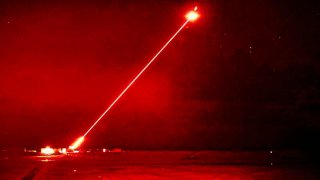DragonFire: The British Military Wants Laser Weapons to Destroy Drones
DragonFire isn't the name of a new Game of Thrones spinoff, but it is possibly powerful enough that it could shoot down the mythical beasts from the hit series House of the Dragon. It is the new high-power laser weapon that is being developed to counter aerial targets, including drones.
DragonFire isn't the name of a new Game of Thrones spinoff, but it is possibly powerful enough that it could shoot down the mythical beasts from the hit series House of the Dragon. It is the new high-power laser weapon that is being developed to counter aerial targets, including drones.
The DragonFire also has a far greater range than the fire-breathing creatures of lore – able to strike a £1 coin from a distance of up to a kilometer away, the UK's Ministry of Defence (MoD) announced; but added that its official range remains classified. It is a line-of-sight laser-directed energy weapon (LDEW) that can still engage any visible target, including extremely small ones!
Tests of the platform have been underway at the MoD's Hebrides Range, located off the coast of Scotland.
In addition to its extreme accuracy, the platform can engage targets at the speed of light. In contrast, its intense beam of light can cut through the target, leading to structural failure or more impactful results – such as if an inbound missile's warhead is targeted.
The platform is also highly cost-effective compared to other air-defense systems
"Firing it for 10 seconds is the cost equivalent of using a regular heater for just an hour. Therefore, it has the potential to be a long-term low-cost alternative to certain tasks missiles currently carry out. The cost of operating the laser is typically less than £10 per shot," the MoD explained.The Royal Navy shared images of the recent test firing of the DragonFire on X, the social media platform formerly known as Twitter, with the caption "Hit me with your laser beam... Scientists have successfully shot down drones with Dragonfire - the UK's first laser weapon, which could be fitted to future generations of warships to fend off air and drone attacks."
DragonFire: Counter Drones and Missiles
The development of LDEWs comes amid the increasing use of drones in warfare, which has been seen during the conflict between Ukraine and Russia, with Russia believed to be using Iranian-made "kamikaze" drones to attack Ukrainian cities.
The DragonFire weapon system is the result of a £100 million joint investment by the Ministry of Defence and industry. Together, the companies involved are supporting highly-skilled UK jobs in new cutting-edge technologies that are delivering a significant step-change in the UK’s capability in LDEW systems.
In 2017, the MoD's Chief Scientific Advisor's Research Programme awarded a £30 million ($38 million) contract to the DragonFire consortium to demonstrate the potential of LDEWs.
Air Defense System
Currently, both the British Army and Royal Navy are considering employing the DragonFire technology as part of their respective future air defense capabilities.
"This type of cutting-edge weaponry has the potential to revolutionise the battlespace by reducing the reliance on expensive ammunition, while also lowering the risk of collateral damage," explained the UK's Defence Secretary Grant Shapp. "Investments with industry partners in advanced technologies like DragonFire are crucial in a highly contested world, helping us maintain the battle-winning edge and keep the nation safe."
The recent milestones that were reached with the platform build on a series of highly successful trials, including the first static high-power laser firing of a sovereign UK capability as well as a demonstration of the DragonFire system's ability to track moving air and sea targets with very high accuracy at range.
As a result, the MoD recently announced its intention to fund a multi-million-pound program to transition the technology from the research environment to the battlefield. The latest trial was also sponsored by the MoD's Defence Science and Technology (DST) organization and Strategic Programmes, while it is also being supported by several other agencies across the government, ensuring all regulatory and safety approval requirements were satisfied.
"These trials have seen us take a huge step forward in realising the potential opportunities and understanding the threats posed by directed energy weapons," added Dstl's Chief Executive, Dr. Paul Hollinshead. "With our decades of knowledge, skills, and operational experience, Dstl's expertise is critical to helping the armed forces prepare for the future."
Author Experience and Expertise: Peter Suciu
Peter Suciu is a Michigan-based writer. He has contributed to more than four dozen magazines, newspapers, and websites with over 3,200 published pieces over a twenty-year career in journalism. He regularly writes about military hardware, firearms history, cybersecurity, politics, and international affairs. Peter is also a Contributing Writer for Forbes and Clearance Jobs. You can follow him on Twitter: @PeterSuciu. You can email the author: [email protected].


